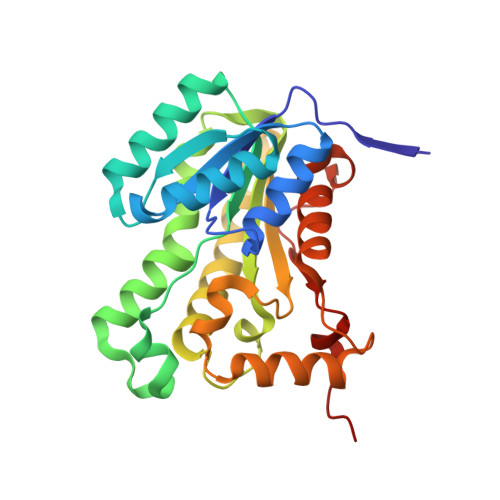High-resolution structures of Thermus thermophilus enoyl-acyl carrier protein reductase in the apo form, in complex with NAD+ and in complex with NAD+ and triclosan.
Otero, J.M., Noel, A.J., Guardado-Calvo, P., Llamas-Saiz, A.L., Wende, W., Schierling, B., Pingoud, A., van Raaij, M.J.(2012) Acta Crystallogr Sect F Struct Biol Cryst Commun 68: 1139-1148
- PubMed: 23027736
- DOI: https://doi.org/10.1107/S1744309112033982
- Primary Citation of Related Structures:
2WYU, 2WYV, 2WYW - PubMed Abstract:
Enoyl-acyl carrier protein reductase (ENR; the product of the fabI gene) is an important enzyme that is involved in the type II fatty-acid-synthesis pathway of bacteria, plants, apicomplexan protozoa and mitochondria. Harmful pathogens such as Mycobacterium tuberculosis and Plasmodium falciparum use the type II fatty-acid-synthesis system, but not mammals or fungi, which contain a type I fatty-acid-synthesis pathway consisting of one or two multifunctional enzymes. For this reason, specific inhibitors of ENR are attractive antibiotic candidates. Triclosan, a broad-range antibacterial agent, binds to ENR, inhibiting fatty-acid synthesis. As humans do not have an ENR enzyme, they are not affected. Here, high-resolution structures of Thermus thermophilus (Tth) ENR in the apo form, bound to NAD(+) and bound to NAD(+) plus triclosan are reported. Differences from and similarities to other known ENR structures are reported; in general, the structures are very similar. The cofactor-binding site is also very similar to those of other ENRs and, as reported for other species, triclosan leads to greater ordering of the loop that covers the cofactor-binding site, which, together with the presence of triclosan itself, presumably provides tight binding of the dinucleotide, preventing cycling of the cofactor. Differences between the structures of Tth ENR and other ENRs are the presence of an additional β-sheet at the N-terminus and a larger number of salt bridges and side-chain hydrogen bonds. These features may be related to the high thermal stability of Tth ENR.
Organizational Affiliation:
Departamento de Bioquímica y Biología Molecular, Facultad de Farmacia, Universidad de Santiago de Compostela, 15782 Santiago de Compostela, Spain.
















